|
April 6, 2017
Stelco and Essar Steel Algoma
Bankruptcy Fraud of the
Financial Oligarchy
PDF
Stelco
and
Essar
Steel
Algoma
• Bankruptcy Fraud of the Financial Oligarchy
• Essar Steel Algoma Intrigue - K.C.
Adams
• CCAA Monitor's Report at Essar Steel Algoma
Strike at CEZinc
• Join April 28 Protest in Toronto --
Demonstrate with CEZinc Refinery Workers!
• Militant Demonstration in the Streets of
Salaberry-de-Valleyfield - Pierre Chénier
Mandate Review of
Canada Post
• New Attacks Being Prepared
Against Postal Workers - Louis Lang
Stelco and Essar Steel Algoma
Bankruptcy Fraud of the Financial Oligarchy
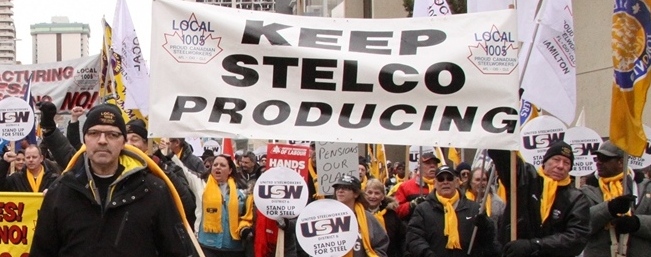
Both U.S. Steel/Stelco and Essar Steel Algoma are
currently under bankruptcy protection of the Companies' Creditors
Arrangement Act (CCAA). Yet, both steel producers are in a business
upswing and making money. Stelco has announced its cash liquidity will
reach $300 million by this June, and Algoma Steel appears to
be booming according to the latest CCAA monitor's report.
Why then are they under bankruptcy protection and
demanding enormous concessions from steelworkers, retirees, unsecured
creditors, municipalities and others? And why indeed is Stelco
continuing to deny retirees the post-retirement benefits for which they
are legally entitled? The simple answer is because they can when using
the police
powers of the CCAA.

The experiences under CCAA point to a situation where
large company bankruptcy protection is not used to solve particular
problems of production and distribution or general problems in a
sector. A certain faction of the financial oligarchy uses the CCAA to
take advantage of a downturn or other difficulties, that may not even
be
related to
the particular company, to attack their competitors, workers, retirees
and others. The faction uses CCAA as a means to a self-serving end that
has nothing to do with solving problems in the economy and industry.
At Stelco, U.S. Steel clearly wanted to eliminate, or
at least cripple, a competing steelmaker. It drove Stelco into a corner
through wrecking of its production capacity, in particular in Hamilton.
After doing so, U.S. Steel went into CCAA to salvage something for
itself from the damage it had deliberately caused and to put a firewall
between its
assets in the U.S. and Canadian workers, retirees and others with
legitimate claims on Stelco.
If the Bedrock proposal for Stelco/U.S. Steel to exit
CCAA succeeds, then U.S. Steel walks away with a payoff of $126
million, plus newly acquired former Stelco steel Canadian customers
supplied from its mills in the U.S., and a much crippled Stelco
competitor. Besides, who knows the insider connections within the
financial
oligarchy and what they are cooking up amongst themselves. The U.S.
oligarchs at Bedrock poised to seize control of Stelco after stripping
pensions, retiree benefits and environmental remediation off the Stelco
balance sheet could very well be financial associates of those who
currently control U.S. Steel. At the very least they represent the same
social class interests. Certain U.S. billionaire oligarchs with
investments in this and that fund could have social wealth and
positions of control in both Bedrock and U.S. Steel.
For example, as Jim Skinner points out in an interview
with Workers' Forum, "Cliffs
[Cliffs Natural Resources from Cleveland] also owned Bloom Lake mine in
Quebec. They bought that for $4.3 billion and sold it (to Champion) for
$10.3 million! We have a problem with that as one of the people on the
Board of Directors of Champion is also the Vice-President of Cliffs. It
is a fire sale and we think there is some collusion there. But Cliffs
cannot be sued while under CCAA."[1]

Through CCAA and its police powers, Bedrock is
conspiring with Canadian state authorities to take the pension and
retiree benefits of Stelco workers off the balance sheet and deny any
responsibility for environmental remediation upon exiting CCAA. This
sets up Stelco/U.S. Steel Canada as a later target of a big score for
the Bedrock
U.S. oligarchs,
just as it was in 2007. At that time, Stelco was stripped
of $1.2 billion by oligarchs who had seized control of Stelco
under CCAA in 2004-06.
Those manipulating the CCAA today may very well be
associates of those in control at U.S. Steel and acting in collusion.
This must not pass! Canadians demand Stelco must keep producing and
meeting its social obligations to workers, retirees, the community and
economy.
No to the CCAA Scams of the Oligarchs!
No Means No!
Note
1. Jim Skinner is a member of the
Wabush Pension Committee waging a
determined battle to uphold the rights of miners and retirees in
opposition to the anti-worker dictate of the CCAA courts. Jim is a
former President of United Steelworkers Local 6285 representing
workers
at Wabush Mines located in Labrador whose owner Cliffs is being
protected under the police powers of the CCAA.

Essar Steel Algoma Intrigue
- K.C. Adams -
The situation at Essar Steel Algoma is a tale of CCAA
intrigue similar to that of U.S. Steel/Stelco. But in the case of
Algoma Steel, powerful global oligarchs are openly fighting for
control. Investigating a CCAA bankruptcy is like suddenly turning on
the lights in a cheap hotel and watching all the
cockroaches scurry for
cover. The knives are out amongst the oligarchs and not one has the
interests of the Canadian economy and working people in mind. Far from
it. The oligarchs duking it out for the Algoma Steel spoils are a real
rogues' gallery of global bandits.

The spectacle has the now infamous Cliffs Natural
Resources from Cleveland extending into Canada its fight and
competition with Essar Global Funds over control of iron ore deposits
and mining in Minnesota. Cliffs accuses Essar Global of being unstable
and incapable of managing Algoma because of its financial troubles in
Minnesota where
Cliffs and Essar are in a no-holds-barred battle for control of iron
ore resources and mining rights. Cliffs even introduced a motion into
its iron ore supply contract with Algoma prohibiting the company from
considering any Essar Global CCAA restructuring proposal. In a
situation resembling a macabre comedy, Cliffs itself, while denouncing
Essar Global for instability, is engaged in a nasty CCAA bankruptcy of
its own making in Labrador and Quebec, as it tries to destroy iron ore
producing competitors in Canada as well as Essar Global in Minnesota.
The list of oligarchs fighting it out over the spoils
of Algoma Steel contains some of the most powerful in the world:
Deutsche Bank and Essar Global Fund of course but also Golden Tree and
Bain Capital from the U.S., the two largest secured creditors
conspiring to defend their narrow private interests and empires.
Within the destructive fight amongst the oligarchs, the
CCAA process also takes aim at Algoma steelworkers and salaried
employees demanding more than 40 concessions in new collective
agreements
including an across the board 10 per cent wage cut. The aim of a
particular CCAA process has nothing to do with solving problems within
the economy, sector and facility but is essentially the exercise of
police powers to serve the narrow private interests of the oligarchs in
control who stand opposed to the interests of working people and the
Canadian economy and society.

CCAA Monitor's Report at Essar Steel Algoma
The bankruptcy monitor Ernst & Young reports Essar
Steel Algoma shipped more steel per day at a higher selling price in
February compared to January. The monitor says, "Algoma has experienced
an improvement in average selling prices coupled with strong production
volumes." This amounted to 194,000 net tons shipped,
or 6,928 net tons per day. Average selling price climbed
to $739 (per ton) from below $700 in January with the selling
price expected to improve in the coming months. Algoma Steel under CCAA
bankruptcy protection declared earnings of $28 million for the
short month on gross income of $157 million. (All
prices in U.S. dollars.) The court document says, "Steel prices have
increased by 72 per cent between December 2015 and
March 2017 and the forecast is favorable for continued increases
over the next few months."

The solid income and prospects have not stopped those in
control of the CCAA process from demanding concessions from
steelworkers and salaried employees. To meet their anti-worker aim and
put pressure on workers, the CCAA judge in charge ordered the
negotiating committees for United Steelworkers Local 2251
and 2724
sequestered incommunicado in Toronto from March 22 until
March 30.
Various oligarchs circling Algoma demand their pound of
flesh from the earnings while denying the actual producers and retirees
their legitimate claims. The Debtor-In-Possession (DIP) lenders led by
Deutsche Bank are claiming ever increasing amounts from the value
Algoma workers produce. The DIP lenders received another prepayment
of $10 million on March 31, plus an additional $2.1
million in monthly fees under the third amendment to the DIP agreement
and a $1.25 million penalty the judge awarded them because Algoma
Steel has so far failed to extract $22.2 million in concessions
from workers who have held firm that No Means
No!
Note from the Monitor's Report
The monitor says Algoma Steel has been complying with
prepayment requirements under the DIP term facility, mainly to Deutsche
Bank. During the last six weeks alone, Algoma has prepaid about
US $42.7 million (C$57.1 million) in interest and principal.
The payments are being made through court-ordered "cash
sweeps" payable to the DIP lenders every week. If
the steel mill's unrestricted cash exceeds US$25 million at the end of
any Friday, it must "sweep" the excess (calculated to the nearest
US$100,000) to the DIP lenders.
Meanwhile under a CCAA court order, no payments are
allowed to go to the steelworkers and salaried employees' underfunded
pension plans or for the tens of millions of dollars owed to the City
of Sault Ste. Marie for property taxes, and other money owed to local
suppliers and contractors.
In addition to the cash sweep for the period
March 25 to May 5, Algoma is expected to pay US$7 million for
interest and fees (not principal) for the DIP facilities, and $6
million for CCAA lawyers and court fees.

Strike at CEZinc
Join April 28 Protest in Toronto --
Demonstrate with CEZinc Refinery Workers!

CEZinc workers demonstrate, March 29, 2017 in Salaberry-de-Valleyfield,
Quebec.
Friday,
April 28
-- 10:00
am
Toronto Stock Exchange, TMX Broadcast
Centre
130 King Street West, Toronto
|
|
Workers on strike at the CEZinc refinery in
Salaberry-de-Valleyfield, Quebec, will be in Toronto on Friday,
April 28, for a demonstration at the Noranda Income Fund's (NIF)
Annual General Meeting. NIF owns CEZinc. Other steelworkers and their
allies from Quebec and Ontario will also be there to support the CEZinc
workers. All
friends and allies of the workers' movement are invited to attend and
show the financial oligarchy that workers stand as one in defence of
their rights.
Workers' Forum calls on workers to join the
demonstration in Toronto and stand firmly with the
Salaberry-de-Valleyfield workers in their fight for their rights
against the global mining oligopoly Glencore and the Noranda Income
Fund. Glencore controls NIF through ownership of 25 per cent of
its stock and operates the
refinery.
Call of Alain Croteau, Quebec Director of the Syndicat
des Métallos (United Steelworkers) to Demonstrate in Toronto
Alain Croteau speaking at a demonstration in support of
the striking CEZinc workers on March 29 called on workers to
demonstrate in Toronto on April 28:
"We know that it is Glencore that is pulling the
strings in the back with the Noranda Income Fund. There is going to be
a general meeting of shareholders of the Noranda Income Fund on
April 28 in Toronto. The Quebec and Ontario steelworkers will be
there where the meeting is taking place and at the meeting itself to
defend their
rights in front of the shareholders so that they know exactly what is
happening," Alain said.
"Following this action, we are going to launch a
corporate campaign across the United States and other countries if
necessary. It is difficult to sustain a strike, but there is a good
strike fund and we are receiving financial assistance from several
locals in Quebec and several locals from the rest of Canada have also
committed to provide
financial assistance," he added.
Glencore and Noranda Income Fund
The Noranda Income Fund owns CEZinc. The global
Glencore empire owns 25 per cent of the NIF stock listed on the
Toronto Stock Exchange and operates the refinery. Glencore is also the
exclusive supplier of zinc concentrate to CEZinc and the sole purchaser
of the zinc metal and by-products that come out of the plant.
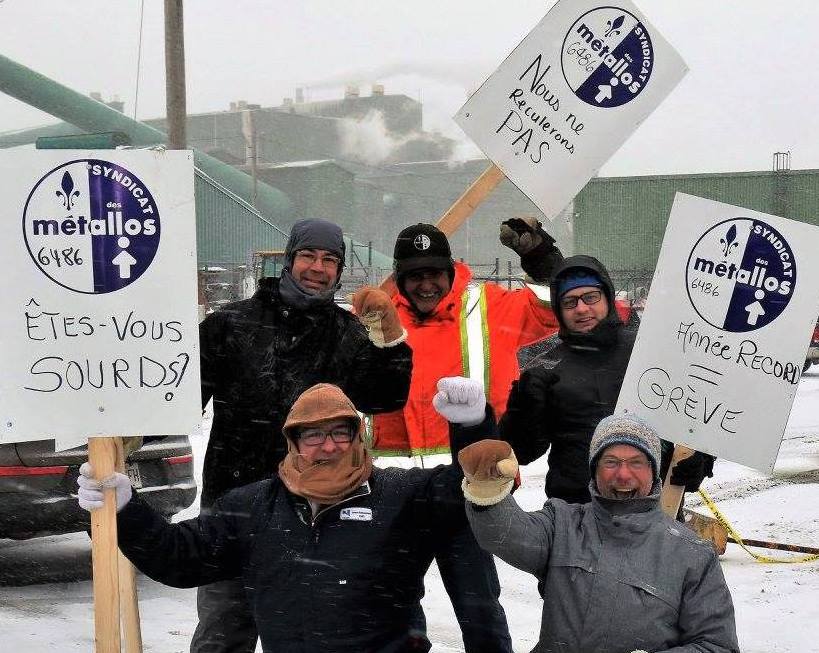
The 371 CEZinc workers have been on strike since
February 12 against demands for concessions from NIF, in
particularly to reduce wages and weaken their pension plan. NIF wants
to introduce a system of gradually reducing wages and transferring that
amount into the pension fund. The company would then reduce the value
it
puts into the pension fund by the same amount. This directly lowers the
wages of workers with the amount going into the coffers of NIF, as
added-value. The company also wants to increase the age for early
retirement for all workers. This particularly affects workers who might
benefit from early retirement due to wear and tear on their bodies or
for other personal reasons.
Workers reject the concessions as an attack on their
rights. They see changes as an effort to lower their working conditions
and wages to an uncertain end. The concessions could then become a
template and applied to other workers in the Glencore empire.
Already Glencore has threatened workers at the Horne
copper smelter in Rouyn-Noranda that their pension plan could be the
subject of a similar attack when their collective agreement is up for
renewal in 2018. CEZinc workers blame the global oligopoly
Glencore and NIF for these concessionary demands and insist they must
be
withdrawn. Their slogan is We Will Not Back Down! This is
the message they are taking to shareholders and Torontonians on
April 28.

Militant Demonstration in the Streets of
Salaberry-de-Valleyfield
- Pierre Chénier -

More than 400 CEZinc workers and their allies
demonstrated in the streets of Salaberry-de-Valleyfield in the early
evening of March 29. They marched in solidarity for their just
strike against Noranda Income Fund and the global mining oligopoly
Glencore.
CEZinc workers, who began their strike on
February 12, held high their union flags and banner emblazoned
with We Will Not Back Down! An impressive number of other
steelworkers joined the demonstration including workers from Samuel and
Son, themselves on strike since February 4, and others from Ciment
Lafarge.
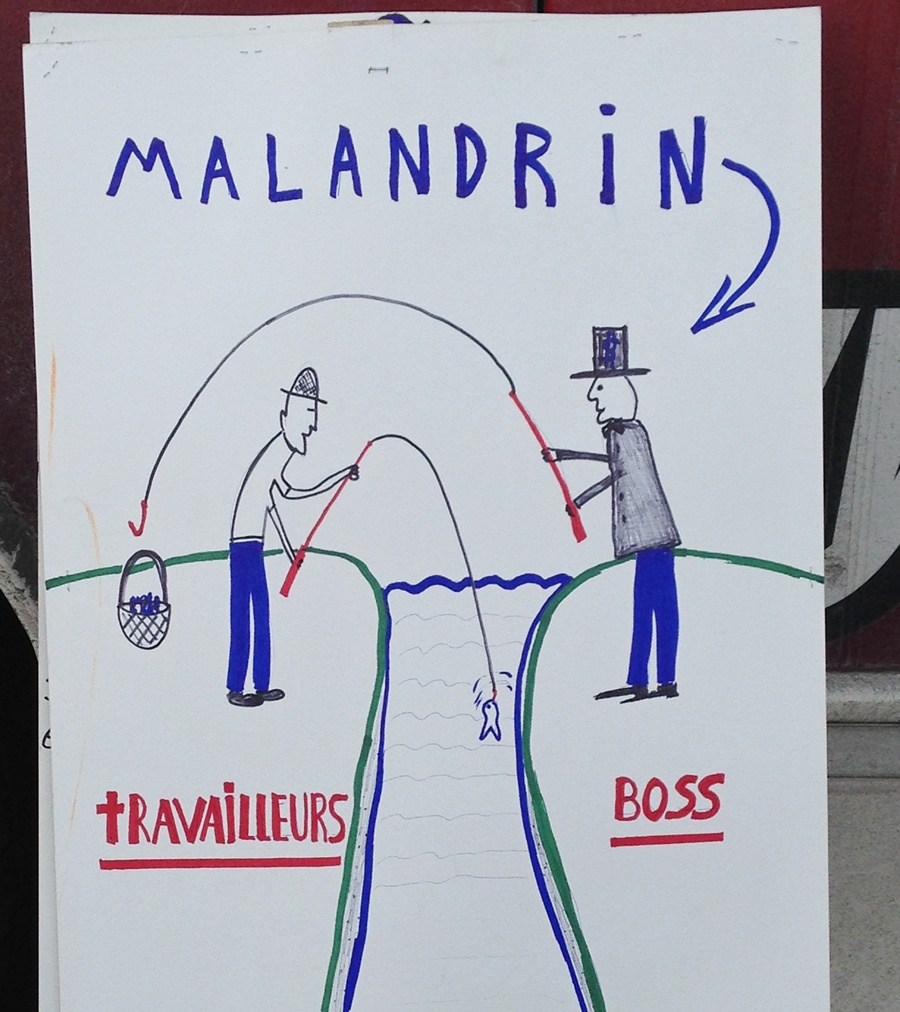
The demonstration welcomed the participation of more
than 20 workers from the Horne copper smelter who made
the 12-hour bus trip from Rouyn-Noranda. The mining giant Glencore
also controls the Horne smelter.
With their banners, flags and signs, the demonstrators
marched through the streets of this industrial city located on the
Île de Salaberry in the Saint Lawrence River southwest of
Montreal. They were greeted along the route by residents and
shopkeepers who came out of their houses and stores to show their
support. People know the difficult
and often dangerous work of CEZinc workers with all the toxic products
in use at the refinery and the constant battle to defend the rights and
health and safety of workers and the nearby population.
The demonstrators were deeply moved that the action
ended in front of the sculpture Le Souffle d'Éole, a
symbol of the heroic 1946 strike of more than 3,000 textile
workers at Montreal Cotton in Valleyfield. The workers fought a
courageous battle for the improvement of their working conditions and
the recognition of
their rights, which included legal recognition of their union in a city
that was practically owned by the company. The workers did not back
down in the face of the police powers and violence of the Quebec
Duplessis government.

Demonstration March 29, 2017, concludes in front of the sculpture Le
Souffle
d'Éole.
Comments of Worker Representatives Manon Castonguay
and Mario Montmigny
Manon Castonguay, President of USW Local 6486
representing CEZinc workers said, "We are very pleased with the visit
of our brothers and sisters of the Horne smelter. We are fighting to
preserve the conditions that generations before us have struggled to
obtain, here as in Rouyn-Noranda or at Glencore in Montreal East. Our
struggle
resonates with others because it is universal. Everywhere, the big
corporations try to pocket more profits by siphoning from the workers.
We refuse, we resist! We can do it thanks to our solidarity!"
Mario Montmigny, President of the Syndicat des
travailleurs de la mine Noranda said, "The struggle of the workers of
CEZinc is also ours. We have the same pension plan that they have, and
there is a good chance that we are going to face the same greedy
demands in our next negotiations as those that are being made here. In
the face of
multinationals such as Glencore, we draw strength from our solidarity.
It was important for us to support other union members who resist these
demands for rollbacks."
Unity in Action
Since 2016, workers throughout Quebec have been
building an inter-union cooperation regardless of specific affiliation.
They have been holding joint actions to support one another when on
strike, such as the demonstration on March 29, and in defence of
their common pension fund and in opposition to subcontracting.

At present the joint actions include the Horne workers,
who are unionized with the CSN (Fédération de l'industrie
manufacturière), the Glencore steelworkers who are members of
the Syndicat des Métallos, as are the CEZinc workers, plus
workers at CCR, a copper and precious metals refinery in Montreal-East,
and workers of the Fonderie
générale du Canada in Lachine.
The Glencore steelworkers, including representatives of
the CEZinc strikers visited the Rouyn workers earlier and the Rouyn
workers reciprocated on March 29, taking part in the demonstration
with their banner On the Road to Negotiations. The enthusiasm
of all the workers from different unions for this precious unity in
action for a common cause has been palpable wherever the workers have
gathered.

Mandate Review of Canada Post
New Attacks Being Prepared Against Postal Workers
- Louis Lang -
The last round of negotiations between Canada Post and
the Canadian Union of Postal Workers ended in a stalemate. For ten
months of what was called negotiations, Canada Post refused to
negotiate and instead used threats of lockout and other brutal threats
to force the Union to accept roll-backs, but the intimidation did not
work.

Finally with the involvement of federal mediators, a
tentative agreement was signed in September 2016 and was later
approved by the workers in spite of the fact that the new contract is
for a two-year term and expires on January 31, 2018. This
continues the situation of insecurity for the workers who have been
facing
further attacks on their pensions, benefits and working conditions as
this short-term contract expires.
Faced with the determination of the workers not to
accept roll-backs, the Trudeau Liberals, who had campaigned in the
election with promises of restoring home delivery and reversing the
cut-backs imposed by Canada Post, were not in a position to impose
roll-backs on the workers by force.
The short-term agreement did not resolve any of the
most important issues faced by the workers, like the ultimatum of the
corporation to eliminate the Defined Benefit Pension Plan, the
further privatization of postal services by eliminating the remaining
CUPW-staffed retail offices with losses of thousands of positions and
staffing
problems with the increased use of precarious part-time and temporary
employment eliminating full-time jobs.
While the Trudeau government pretends to support "a
balance in collective bargaining," and "good faith negotiations," to
resolve the issues, the experience of postal workers tells a different
story. During the last round of negotiations when postal workers were
facing threats of lock-out and unilateral changes in working conditions
by Canada
Post if they did not accept devastating roll-backs, the government's
commitment to "free collective bargaining" was nowhere to be seen.[1]
Instead of instructing the Crown Corporation to
negotiate seriously, the Trudeau Liberals launched a Mandate Review of
Canada Post to directly interfere in negotiations in an attempt to
pressure the Union and workers to accept the roll-backs voluntarily.
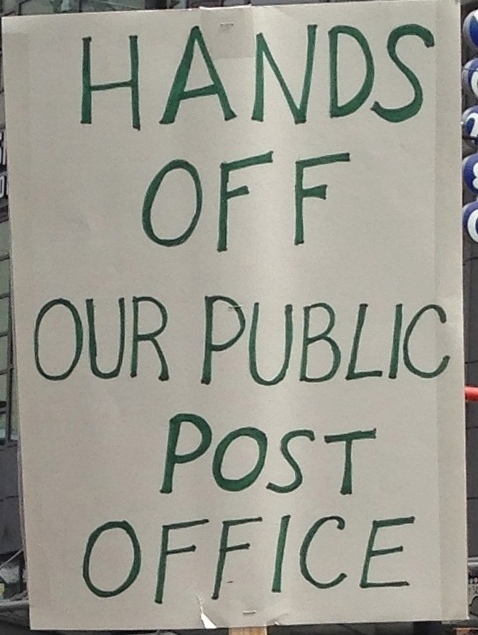
On September 12, 2016, a four-member panel
appointed by the government released a report entitled, "Canada Post in
the Digital Age." Under the guise of informing Canadians and
Parliamentarians about Canada Post's financial situation and the "needs
of
Canadians and viable options," the discussion paper was used to spread
disinformation about a "crisis" in the pension plan and to present
Canadians with a fait accompli
that the "dire financial situation" of
the
corporation makes service cuts unavoidable. The government made sure
that the public consultation on the future of Canada Post was limited
to what to cut and how much.
The so-called discussion paper was then sent to the
House of Commons Standing Committee on Government Operations and
Estimates which also released a report on December 13, 2016,
"The Way Forward for Canada Post," which "includes recommendations to
the government of Canada on the future of Canada
Post."
Past experience with the Trudeau Liberals has shown
that the government will do whatever it wants with the report and is
scheduled to announce its decisions regarding the "future direction of
Canada Post," in the next few days or weeks, this spring.
This entire procedure speaks volumes about the
hypocrisy of a government which swears to respect "a balance on
collective bargaining" but in practice does everything to undermine any
discussion on the demands of the workers or the need for a public
postal service.
Canada Post management is also preparing for a new
round of attacks against postal workers. With full knowledge of the
soon-to-be-announced government plans, the corporation has launched a
series of unilateral changes in working conditions in violation of the
collective agreement.
On March 10, 2017, on the same day that the corporation
held meetings on the shop floor, the Union was notified that the
corporation intended to implement a major restructure of delivery
operations in the urban unit. The change would introduce "night
routers" at letter carrier depots to perform the function normally done
by letter
carriers, to separate and prepare mail for delivery.
Without any consultation with the union about how this
change would affect the work performed by letter carriers, including
the
length of routes and the reorganization of the work required, the
corporation announced to the workers that the changes would be
implemented on September 18, 2017.
This method of using night sorters was attempted more
than 25 years ago but was immediately opposed by the workers
because it was highly inefficient and was intended to increase the
burden of work on letter carriers by lengthening routes and time spent
on their routes. The corporation's plan at that time failed and has not
been used
since.
Introducing such drastic changes without any
consultation is a clear indication of the methods the corporation
intends to follow in preparing for the upcoming round of negotiations.
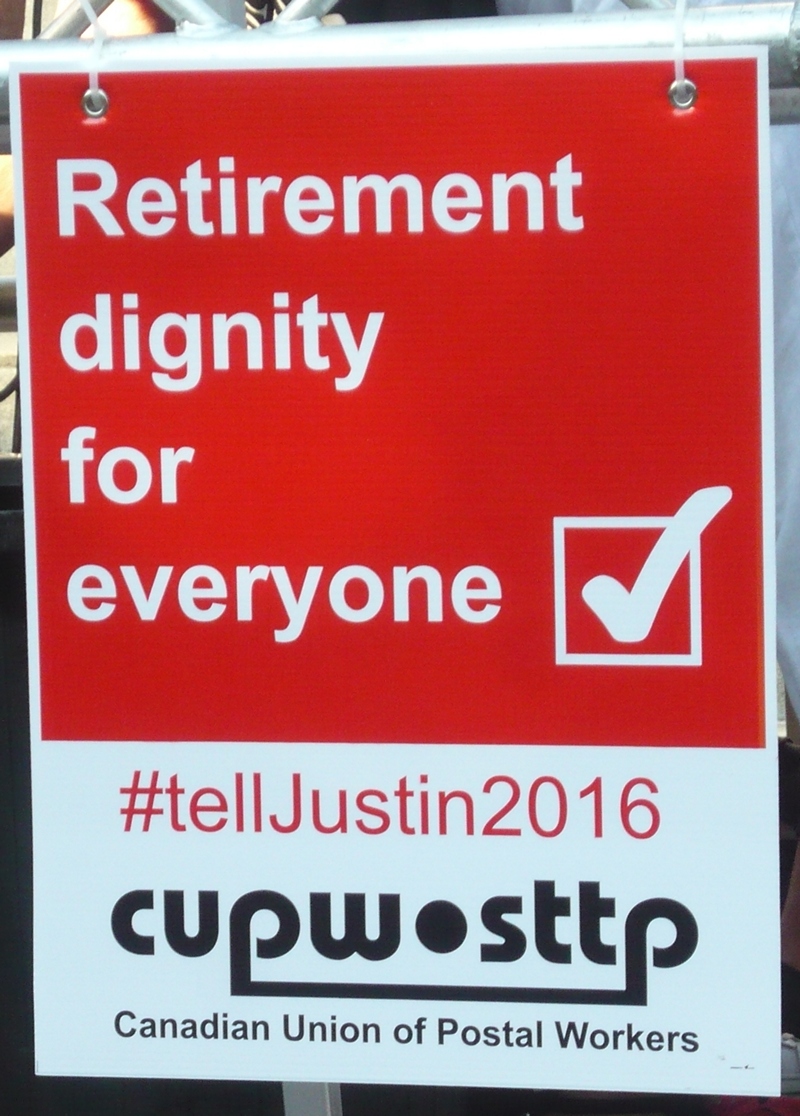
Also in coordination with government attacks on postal
workers, the corporation has recently informed the Union that it
intends to implement a "shared risk" model for pensions to replace the
Defined Benefit Pension Plan which exists presently. This follows the
introduction of Bill C-27 by Finance Minister Morneau, An Act to Amend
the Pension Benefits Standards Act, 1985. This
legislation, if passed, gives Crown Corporations the power to establish
Target
Benefit Plans to replace the Defined Benefit Plan and would eliminate
the
right of workers to a secure pension and absolve the corporation of any
responsibility to provide workers with a proper standard of living in
retirement.
It is clear that the temporary stalemate in last year's
negotiations and the short two-year agreement was a prelude to renewed
attacks on postal workers who are fighting for their rights.
With the Mandate Review and Bill C-27, the Trudeau
government intends to take important issues like pensions and working
conditions and benefits and the future of Canada Post out of the realm
of any discussion or negotiation and impose its dictate not just on
workers but all Canadians as well.
In the coming period the strength and unity of postal
workers and their ability to fight to defend their rights deserves the
support of all Canadians who want the future of a public Post Office to
be in the hands of the workers and the people and not under the dictate
of the ruling elite.
Note
1. "Defend the Right of
Postal Workers to a Say in Their Working
Conditions," TML Weekly, August 27, 2016.

PREVIOUS
ISSUES | HOME
Website: www.cpcml.ca
Email: office@cpcml.ca
|












